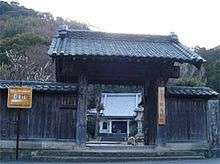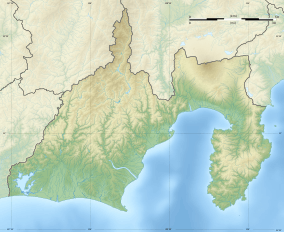Ganjōju-in
Ganjōju-in (願成就院), Buddhist temple of the Kōyasan Shingon-shū sect in Izunokuni, Shizuoka Prefecture, Japan. Its main image is a statue of Amida Nyōrai. The temple grounds have been designated as Historic Site of Japan on February 14, 1973.[1][2]The temple is noted for a set of statues by the famed Kamakura period sculptor Unkei which are collectively designated a National Treasure of Japan.
| Ganjōju-in | |
|---|---|
願成就院 | |
 Gate of Ganjōju-in | |
| Religion | |
| Affiliation | Buddhism |
| Deity | Amida Nyōrai |
| Rite | Kōyasan Shingon-shū |
| Location | |
| Location | 83-1 Jike, Izunokuni-shi, Shizuoka-ken 410-2122 |
| Country | |
 Ganjōju-in  Ganjōju-in (Japan) | |
| Geographic coordinates | 35°02′44″N 138°56′24″E |
| Architecture | |
| Founder | Hōjō Tokimasa |
| Completed | 1189 AD |
| Website | |
| ganjoujuin | |
History
Per the Azuma Kagami, Ganjōju-in was founded in 1189 by Hōjō Tokimasa to pray for the victory of the Minamoto forces in their campaign against the Northern Fujiwara at Hiraizumi. However, the temple's famed statues by Unkei are all dated 1186, or three years before the campaign, indicating that the temple was actually intended as a bodaiji for the Hōjō clan. The temple continued to expand during the tenures of Hōjō Yoshitoki and Hōjō Yasutoki, becoming the largest and most important temple in Izu Province during the Kamakura period. However, the temple's prosperity was short-lived. During the wars of Hōjō Soun in the late Muromachi period, the temple was burned down in 1491 and although reconstructed, was burned down again by the forces of Toyotomi Hideyoshi during the 1590 Siege of Odawara. Under the Tokugawa shogunate, the temple was rebuilt in by Hōjō Ujisada (1703-1758) daimyō of Sayama Domain and the present Hondō dates from 1789, although all buildings of the temple were extensively rebuilt in 1967.
Cultural properties
National Treasures
Ganjōju-in statues by Unkei
Ganjōju-in houses some of the few remaining works which can be definitely attributed to the Kamakura period sculptor Unkei: wooden images of Amida Nyorai, Bishamonten, Fudō Myōō and two attendants.[3] Based on inscriptions found inside the sculptures, this group has been dated to 1186. Since June 19, 2013 these statues have been collectively designated a National Treasure of Japan. [4]
Gallery
 Hondō
Hondō Grave of Hōjō Tokimasa
Grave of Hōjō Tokimasa
See also
References
- 国指定文化財 データベース [Database of National Cultural Properties] (in Japanese). The Agency for Cultural Affairs. 2008-11-01. Retrieved 2015-10-28.
- 史跡願成就院跡 [Historic Site Ganjōju-in] (in Japanese). Izunokuni city. Retrieved 2015-10-28.
- "願成就院" [Ganjōju-in]. Digital Daijisen (in Japanese). Shogakukan.
- 【国宝】願成就院の運慶作諸仏 [National Treasure: Various images by Unkei at Ganjōju-in] (in Japanese). Izunokuni city. Retrieved 2015-10-28.